
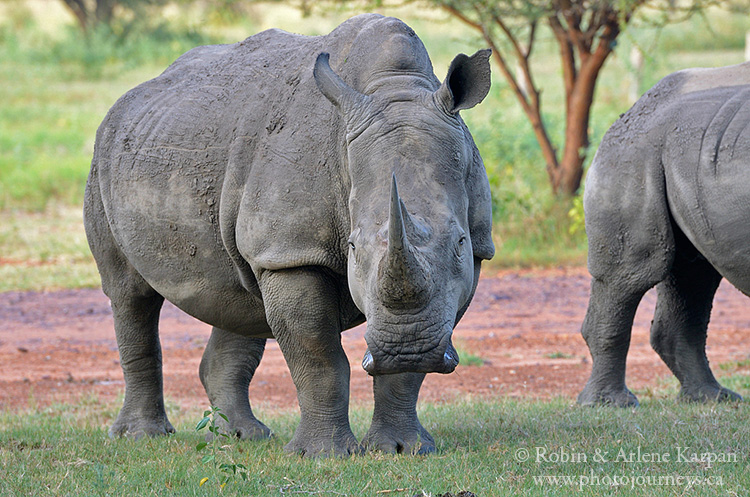
The two-ton monster stares at us through the front door of our tiny tent, its long, curved horn pointing like a dagger. If that’s not enough to stir us from slumber, four of its buddies have us surrounded. Without warning a scuffle breaks out between two of them, with plenty of snorting and foot stomping sending bits of dirt and gravel flying against our tent. Never again will we complain about not getting close enough to rhinos.
Marakele National Park
We’re camped in South Africa’s Marakele National Park, a beautiful spot in the Waterberg Mountains noted for its wildlife. More than anywhere in Africa, South African wildlife parks are well set up for independent, do-it-yourself wildlife safaris. We’ve explored many of the parks by rental car, spending days cruising park roads and photographing a mind-boggling array of critters from lions and leopards to elephants, hippos, antelope galore, and dazzling birds. We stay in park rest camps with accommodation ranging from air-conditioned bungalows to simple huts and campgrounds. As a general rule, campgrounds are situated in rest camps that are fenced so that nothing eats you or tramples you in the night.
Marakele is a exception.
A fence divides the park in two. One part is a mountainous, heavily forested area that is home to all of the Big Five (lions, leopards, elephants, buffalo and rhinoceros) plus the world’s largest colony of endangered cape vultures. To get there we follow a long, winding, and steep one-lane road to the top of the highest mountain. The road is so narrow that it takes some tricky manoeuvering to pass an oncoming car without going over the edge. Fortunately, traffic is light. Not only do we have sweeping views from the top, but also have a reasonably close look at these increasingly rare birds that are among Africa’s bigger raptors.
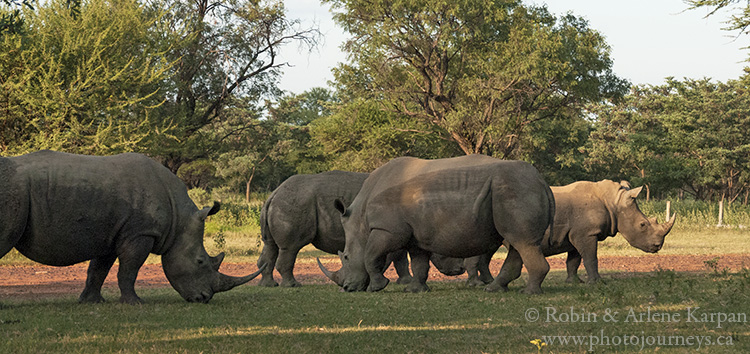
The other part of the park is in the Kwaggasvlakte Plains, with plenty of wildlife, but just one of the Big Five – rhinos. The only accommodation option here is an unfenced campground. We set up our tent among the other tents, trailers, and truck campers, and can’t help but notice that ours is the smallest tent by far. We look over a waterhole in the distance, and throughout the afternoon watch zebra, kudu, and other animals come and go. Since there are no big predators such as lions and leopards, the wildlife tends to be more relaxed and less afraid. It’s not unusual for some to wander into the campground. Ostrich are the most common visitors. Quite bold, they wander fairly close to people, always on the lookout for unattended food. These flightless birds seem even bigger and more imposing close up, their heads stretching nearly three metres above the ground.
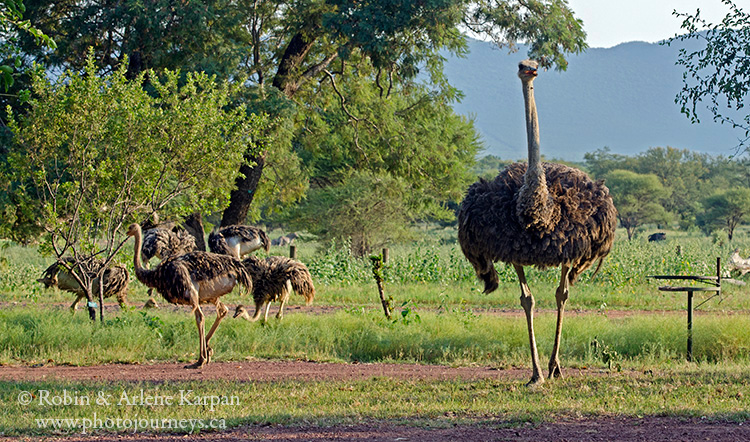
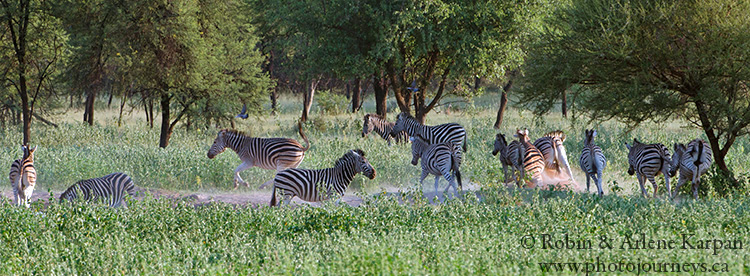
Close to evening, we see a mother white rhino and half-grown calf drinking at the waterhole. We set up our longest telephoto lens and start photographing as they munch on grass practically non-stop. The largest and most numerous of the world’s five rhino species, everything about the “white” is massive, from its weight that can top two and a half tons, length up to four metres, and folded skin resembling armour plating. Despite the name, the white rhino isn’t white, but a medium grey. Dutch settlers named the rhino for its wide mouth that is tailor-made for grazing. Somewhere along the way, the English word white came into use, since it sounds similar to the Dutch word for wide.
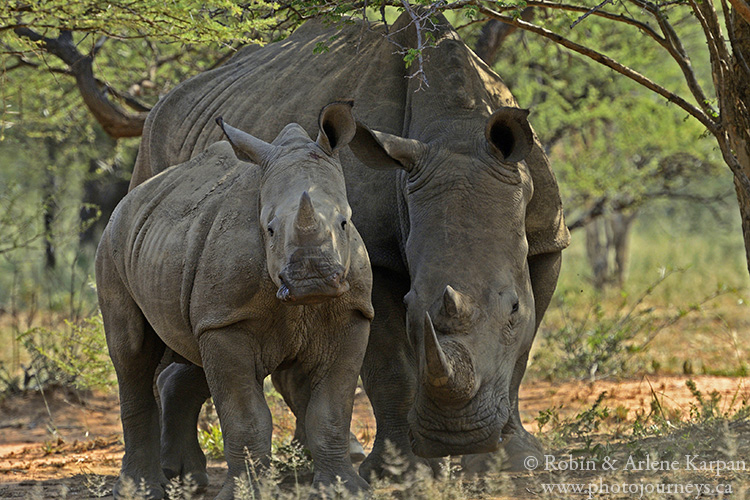
The rhino’s great curved horns are both its defining feature and its curse. Demand for rhino horn in Asia has led to a poaching problem that is putting these magnificent creatures in serious danger. After years of progress in bringing rhinos back from near extinction, they may once again be heading for the brink. The irony is that despite medicinal claims, scientists tell us that consuming rhino horn, which is composed of keratin, has about the same medicinal value as eating fingernails.
The pair keep walking in our direction, and soon get so close that we have to switch to a shorter lens. Eventually, they walk right to the edge of the campground. Campers gather around to watch, and the rhinos look back, making it difficult to know who is watching whom. Before long, the rhinos get bored and slowly disappear into the forest.

We’re thrilled with this close encounter. But when we chat with the campers next to us, we learn that this was pretty tame. Liz and Bryan from Cape Town have already been here a couple of days. They tell us that the night before, rhinos walked right into camp and grazed next to their tent. For some reason, the rhinos have decided that the campground is an integral part of their daily grazing route, even though there’s plenty of grass elsewhere.
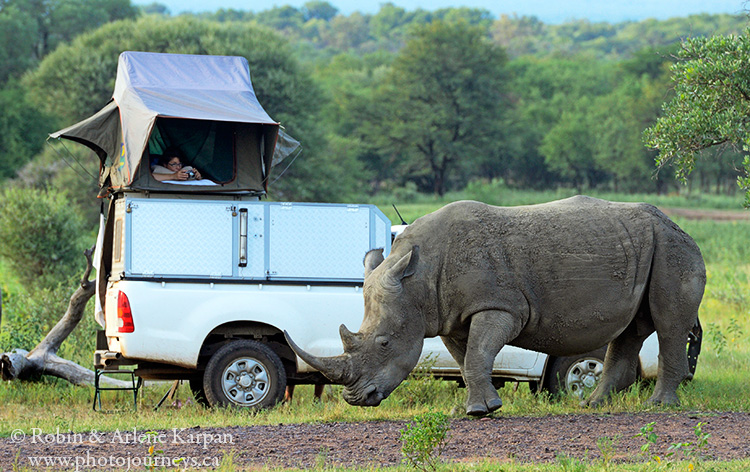
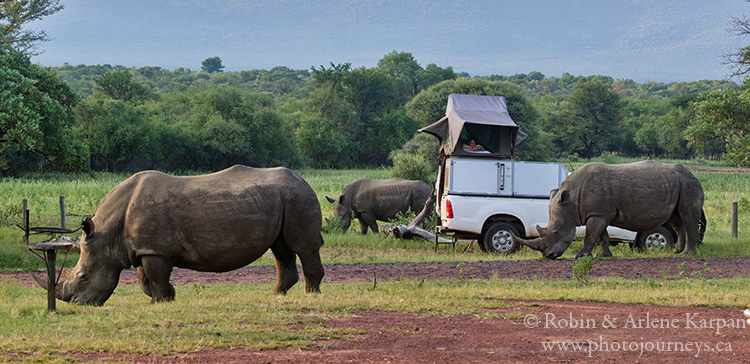
Surrounded by Rhinos
Going to sleep, we assume that the rhinos have had their campground visit that day and are off exploring greener pastures. It’s still dark at 4:00 a.m. when we awake to obvious crunching noises and footsteps of something big – really big. The rhinos are back, grazing just outside. The weather is hot, so we’ve left all the tent flaps open, with only thin mosquito screen between us and the outside world. We count five monsters surrounding our tent. Rhinos look imposing anytime, but a sight we’ll never forget is looking up at them while we’re lying on the ground.
The huge animals aren’t at all aggressive, and fortunately they are walking around the tents rather than over them. Then suddenly the scuffle breaks out. Why, we don’t know. Looking through our screen door, we see one rhino directly in front, its lethal horn pointed at us. The next campsite has a light on, so when the rhino turns sideways, the profile of the curved horn throws a shadow that completely fills our tent door. It feels like something straight out of an Alfred Hitchcock movie, where the knife is about to slash through the shower curtain. There is nothing we can do but wait it out and hope for the best. Fortunately, the animals soon quiet down, continue eating grass for a few more minutes, then eventually wander off. It takes longer for our heart rates to quiet down.
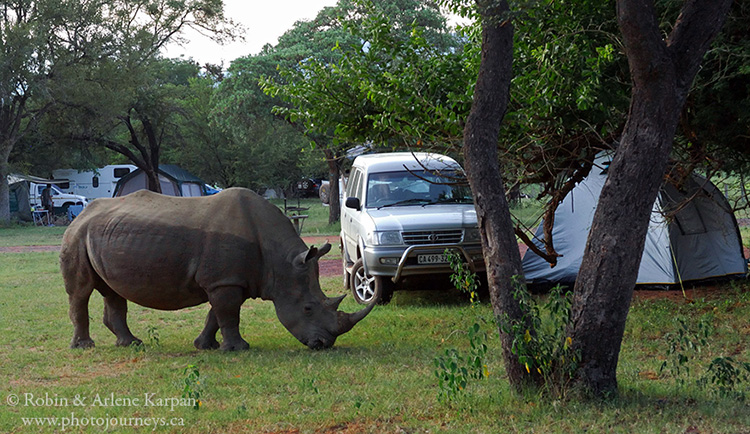
Reinforcing Our Campsite
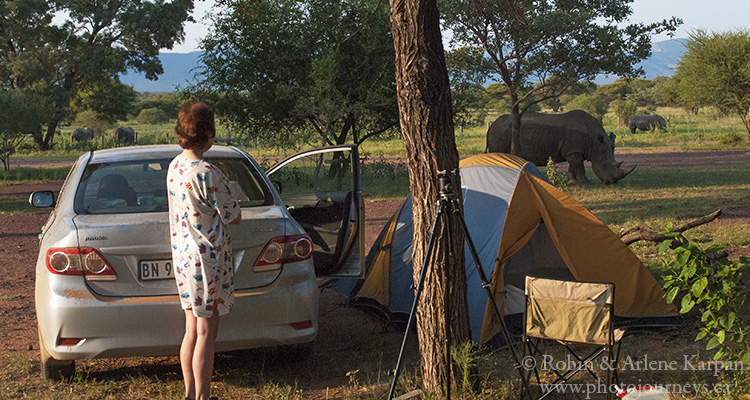
To prepare for the next night, we reinforce the campsite. We park the car immediately beside the tent. On the opposite side, we roll the remains of a dead tree trunk with a protruding branch. At the back of the tent, we put up our lawn chairs, then break out laughing as we think about the absurdity of it all. Yeah, right, nothing like flimsy lawn chairs to stop raging rhinos dead in their tracks! But all we’re trying to do is discourage them from standing too close to the tent while grazing. Judging from last night’s visit, they weren’t disturbing anything around camp. As we look around the sites, other campers have devised similar “barriers”.
We sleep most of the night, then are jolted awake to a commotion outside. It’s the distinctive call of zebras, their strange yelps sounding somewhat like dogs with hiccups. Several of the striped horse-like creatures walk through the campground, and are having an argument among themselves.
Staring Standoff
The sun is shining next time we awake. Looking out the front of the tent, we see that the rhinos are back, six of them this time, grazing on the edge of the campground but slowly working their way toward us. As they inch closer, we decide that it’s safest to get out of the tent and be ready to jump into the car if they come too close. Slowly but surely they keep coming – munch, munch, closer, closer. The gargantuan grass-eating machines seem to completely ignore everything and everyone around them, their heavy heads seldom leaving the ground. Then one big male stops about 10 metres from our campsite, looks up, and stares straight at us. We take this as a cue to get in the car. Clearly, something about us is either troubling him or making him curious. After an uncomfortably long time of staring, he resumes eating and they all slowly move on.
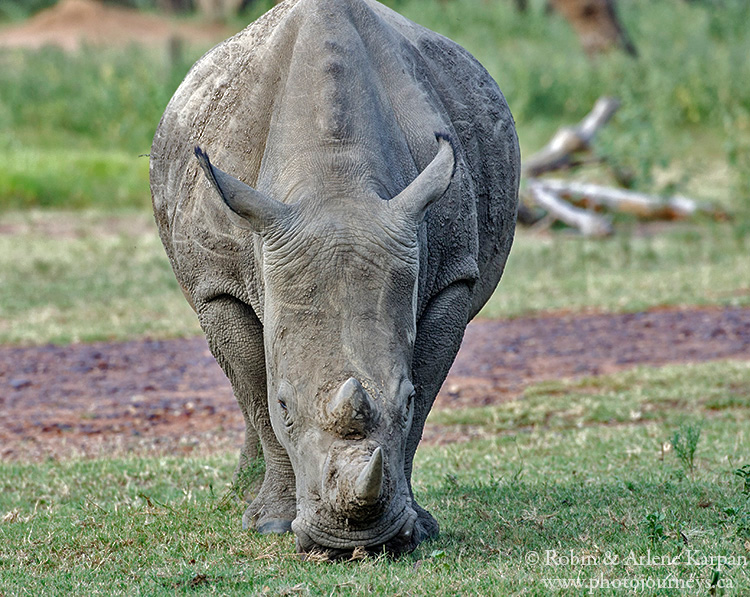
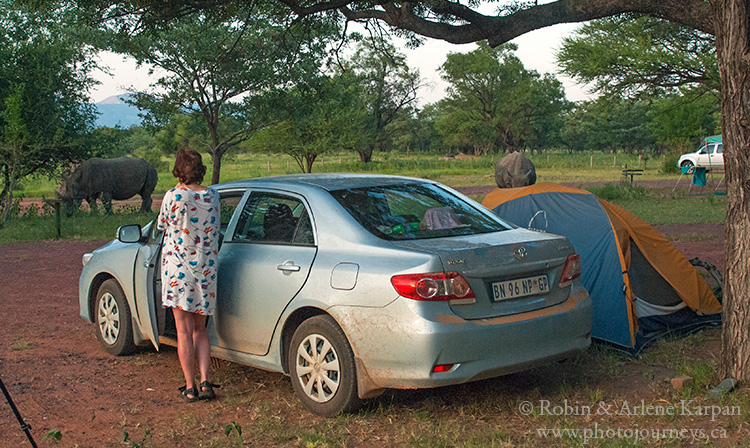
Later we have tea with Liz and Bryan in the next site who had slept through that morning’s visitation while rhinos grazed beside their tent. We mention that we’ll be moving on that afternoon.
“Oh, we were hoping you would stay longer,” says Liz. “Now we’ll have the smallest tent!”
Feel free to PIN this article
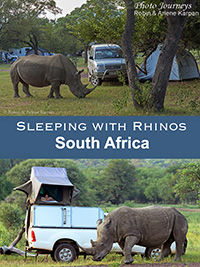


How scary! And what great stories you have to tell! Thanks from former travellers, now armchair bound!